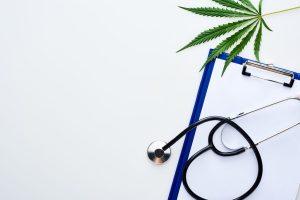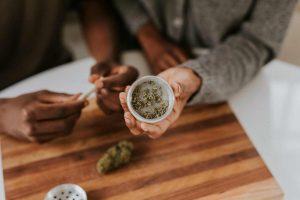Medical Marijuana Without the High
- Nicholas DiBella
- Published: May 10, 2024
- Fact-checked by Dr. Desiree Granados

One of the most groundbreaking advancements in the cannabis industry has been the development of products that offer the medicinal benefits of cannabis without the psychoactive high. This has not only broadened marijuana’s accessibility, but also challenged preconceived notions about the drug. In this article, we’ll explore how to use cannabis without getting high and the benefits of doing so.
Why Does Marijuana Make You Feel High?
When marijuana is consumed, tetrahydrocannabinol (THC) enters the bloodstream, making its way to the brain and other organs throughout the body. It then attaches to receptors that are part of the endocannabinoid system, which plays a crucial role in regulating mood, memory, appetite, and pain. THC’s interaction with these receptors activates the brain’s reward system and triggers the release of dopamine, a neurotransmitter that creates feelings of pleasure and satisfaction.
This process results in the euphoria that cannabis users experience. Additionally, THC can alter your perception, elevate your mood, and enhance your sensory experience.
Does Microdosing Help You Avoid a Marijuana High?
Microdosing, or the practice of consuming small, sub-perceptual amounts of a drug, has emerged as a popular strategy among those seeking the therapeutic benefits of marijuana without the high. This approach allows users to maintain clarity and functionality while still enjoying the anti-anxiety, anti-inflammatory, and mood-regulating effects of the cannabis plant.
When microdosing, modulating your dosage is critical. By carefully calibrating the amount you consume, you can hit a sweet spot where the cognitive and perceptual effects of the marijuana are minimal, yet the physical and emotional benefits are palpable.
While microdosing can indeed help you avoid the traditional marijuana high, its effects can vary greatly from user to user based on factors such as body chemistry, tolerance levels, and the specific strain(s) of marijuana consumed.
Do Cannabis Creams or Topicals Get You High?
Consumer-grade cannabis creams and topicals do not induce psychoactive effects. They are applied externally, so their cannabinoids don’t enter the bloodstream. Instead, they interact with cannabinoid receptors located in the skin, offering targeted relief without the high.
Therefore, you can use these products to alleviate pain or inflammation without experiencing the intoxicating effects you would if you ingested or inhaled cannabis.

Does CBD Get You High?
CBD, short for cannabidiol, is a chemical compound found in the cannabis sativa plant. Unlike THC, CBD is non-psychoactive. This means that it doesn’t produce the “high” associated with THC.
People often turn to CBD products for their therapeutic benefits, such as relief from anxiety, pain, and insomnia. However, it’s important to note that while CBD is generally considered safe, it can cause side effects in some people, such as fatigue and irritability.
What Conditions Can You Treat with Medical Marijuana Without Feeling High?
The key to treating conditions with cannabis without getting high is choosing strains with high levels of CBD and lower levels of THC. Here are some conditions that can be treated with such strains:
- Chronic Pain: CBD has been shown to alleviate chronic pain by reducing inflammation and interacting with neurotransmitters.
- Epilepsy: Certain CBD-dominant strains have been recognized for their ability to reduce the frequency and severity of seizures, particularly in treatment-resistant forms of epilepsy.
- Anxiety and Depression: Medical marijuana can act on the brain’s serotonin receptors to improve mood and mitigate symptoms of anxiety and depression.
- Inflammatory Bowel Diseases: Conditions like Crohn’s disease and ulcerative colitis may benefit from the anti-inflammatory effects of CBD.
- Multiple Sclerosis: CBD can help reduce muscle stiffness and spasms, which are common symptoms of MS.
How to Get the Benefits of Medical Marijuana Without Getting High
Many people want the therapeutic benefits of medical marijuana without the high. Here are several ways to achieve this:
- Use CBD-Dominant Strains: Opt for strains high in CBD and low in THC. CBD is non-psychoactive and can provide relief from pain, anxiety, and inflammation without the high.
- Microdose: Consuming small amounts of THC can allow you to experience its medicinal benefits without strong psychoactive effects. This involves taking doses so small they don’t produce a full-blown high.
- Use Topicals: Products like creams, lotions, and balms infused with cannabis can be applied directly to the skin. These offer localized relief for pain or inflammation without generating a high.
- Use Tinctures: Tinctures are concentrated forms of marijuana that you administer under your tongue. By carefully modulating your dose, you can minimize the substance’s psychoactive effects while still benefiting from its therapeutic properties.
- Use Low-THC Edibles: Choosing edibles with more CBD than THC can also offer medicinal benefits without intense psychoactive effects. However, it’s crucial to start with a low dose since edibles take longer to take effect and can be more potent.
- Vape: Vaporizing cannabis allows you to inhale its therapeutic compounds without the harmful effects of smoke. This method is known for producing a more mild high.
Conclusion
Figuring out how to use cannabis without getting high can seem like a daunting task. However, as we’ve discussed, various strategies and products allow for just that. Whether you’re microdosing, using CBD-dominant strains, applying topicals, indulging in low-THC edibles, or exploring tinctures and vaporizers, the key is to find what works for you personally.
If you’re interested in starting medical marijuana treatment, the Sanctuary Wellness Institute can help. Not only can we connect you with a licensed medical marijuana doctor, but we can also guide you through the process of applying for an MMJ card.
Book an appointment with us today to discover whether you’re eligible for medical cannabis.
States Where We Offer Medical Marijuana Card Services
How we reviewed this article:
- National Institute on Drug Abuse (2015). How does marijuana produce its effects?
https://nida.nih.gov/publications/research-reports/marijuana/how-does-marijuana-produce-its-effects - Team Discover (2023). The Potential Benefits of Microdosing THC: What You Need to Know
https://www.seattlemet.com/discover/thc-delta/microdosing-thc/ - Katrina Lubiano (2024). Can Cannabis Topicals Get You High?
https://neurogan.com/blogs/news/can-cannabis-topicals-get-you-high - Adam Rowden (2018). How might CBD make a person feel?
https://www.medicalnewstoday.com/articles/how-does-cbd-oil-make-you-feel - Sari Harrar (2019). What Medical Marijuana Works For
https://www.aarp.org/health/drugs-supplements/info-2019/cannabis-for-medical-conditions.html - Neurology Center for Epilepsy and Seizures (2024). CBD FOR SEIZURES- USE, EFFECTIVENESS, SIDE EFFECTS, AND MORE
https://www.neurocenternj.com/blog/cbd-for-seizures-use-effectiveness-side-effects-and-more/ - Abbie Rosner (2019). How to Get the Health Benefits of Cannabis Without Getting High
https://www.nextavenue.org/health-benefits-cannabis-without-getting-high/
Current Version
May 10, 2024
Written By
Nicholas DiBella
Fact-checked By
Dr. Desiree Granados
Editorial Process
Our Editorial Process

Nicholas DiBella received his psychology degree from West Chester University of Pennsylvania and has been writing content for the Sanctuary Wellness Institute since 2023. He is passionate about all things health & wellness.







